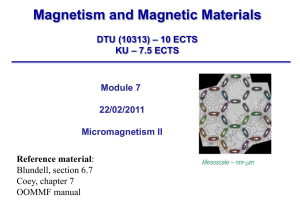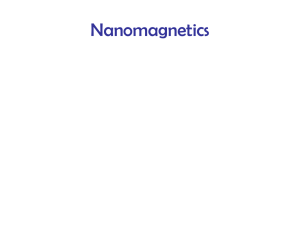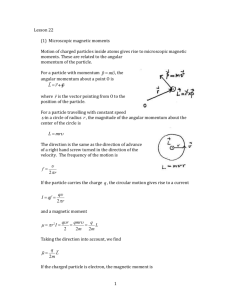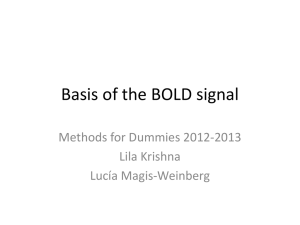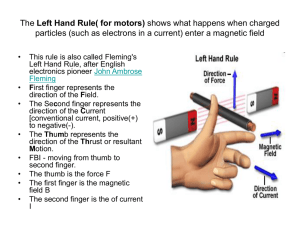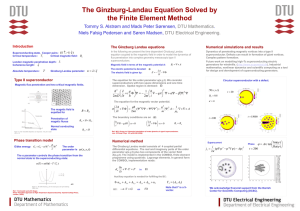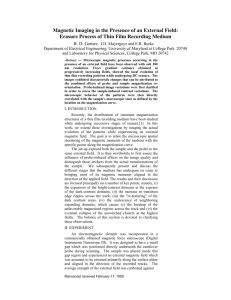Sources of Magnetic Field
advertisement
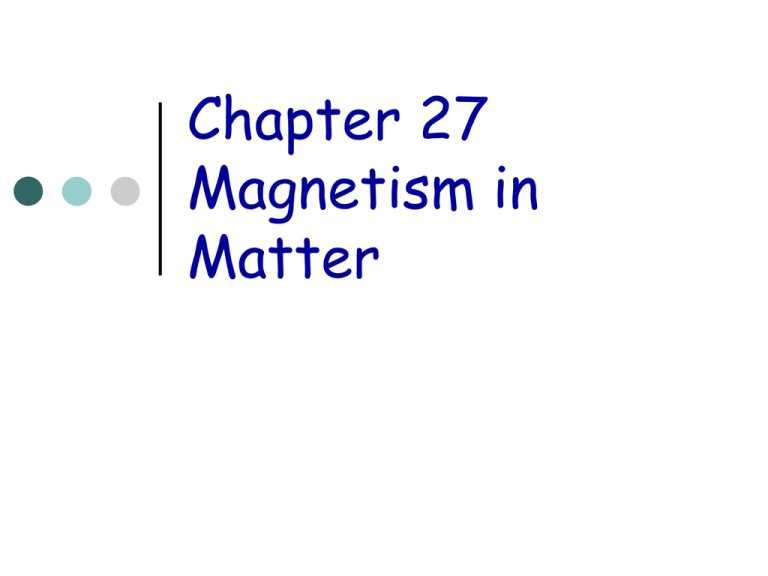
Chapter 27 Magnetism in Matter Topics Magnetization Saturation Types magnetization of materials Magnetization Atoms have magnetic dipole moments due to orbital motion of the electrons magnetic electron moment of the Magnetization Material placed in magnetic field magnetic dipole moments aligned material “magnetized” Magnetization magnetization = net magnetic dipole moment per unit volume d M dV magnetization contributes an additional magnetic, Bm, given by Bm o M Magnetic susceptibility Magnetization M depends on applied field Bapp and the susceptibility m of the material M m Bapp o Bm m Bapp Magnetic susceptibility For paramagnets: For diamagnets: Total field: m > 0 m < 0 B Bapp o M Bapp (1 m ) Km Bapp Km = relative permeability of the material Km 1 m Magnetic moment and angular momentum Angular momentum L r p For circular motion L = rmv Magnetic moment of current loop = IA = Iπr2 For single charge q on circular orbit I = q/T = qv/(2πr) =Iπr2 = qvπr2/(2πr) q = qvr/2 = qL/(2m) L 2m Saturation magnetization Magnetization grows with applied field until all magnetic moments are aligned --“saturation” At saturation, the magnetization is Ms = n•μ, where n is number of atoms per unit volume and μ is the magnetic moment of each atom Types of Materials Materials exhibit three types of magnetism: paramagnetic diamagnetic ferromagnetic Paramagnetism Paramagnetic materials have permanent magnetic moments moments randomly oriented at normal temperatures adds a small additional field to applied magnetic field Paramagnetism Small effect (changes B by only 0.01%) Example materials Oxygen (STP), aluminum, tungsten, platinum Diamagnetism Diamagnetic materials no permanent magnetic moments magnetic moments induced by applied magnetic field B applied field creates magnetic moments opposed to the field Diamagnetism Common to all materials. Applied B field induces a magnetic field opposite the applied field, thereby weakening the overall magnetic field But the effect is very small: Bm ≈ -10-4 Bapp Diamagnetism Example materials High temperature superconductors copper silver Ferromagnetism Ferromagnetic materials have permanent magnetic moments align at normal temperatures when an external field is applied and strongly enhances applied magnetic field Ferromagnetism Ferromagnetic materials (e.g. Fe, Ni, Co, alloys) have domains of randomly aligned magnetization (due to strong interaction of magnetic moments of neighboring atoms) Ferromagnetism Applying a magnetic field causes domains aligned with the applied field to grow at the expense of others that shrink Saturation magnetization is reached when the aligned domains have replaced all others Ferromagnetism In ferromagnets, some magnetization will remain after the applied field is reduced to zero, yielding permanent magnets Such materials exhibit hysteresis Material properties Summary The magnetism of materials is due to the magnetic dipole moments of atoms, which arise from: the orbital motion of electrons and the intrinsic magnetic moment of each electron Summary Three classes of materials Diamagnetic M = - const • Bext, small effect (10-4) Paramagnetic M = + const • Bext small effect (10-2) Ferromagnetic M ≠ const • Bext large effect (1000)

